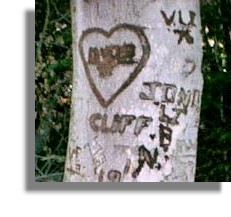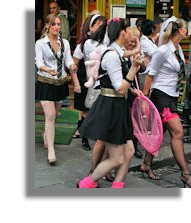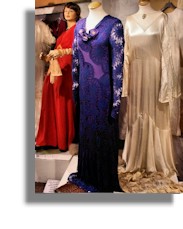

Gaelic and Celtic Customs
from the Hebrides and Beyond
Fada's Farsaing (Far and Wide) is a series of articles by Liam O Caiside in English but with Gaelic words and phrases interwoven in the text. The articles describe a wide range of Gaelic and Celtic customs. These pages were originally published in the "Scottish Radiance" e-magazine and have been reproduced here with the kind permission of the Scottish Radiance editor, Sharma Krauskopf.
Marriage Customs in Scotland
Introduction:Courtship and marriage are important for all societies and all sorts of customs and rituals have arisen which are associated with these events. Here are some of the customs which used to be prevalent in Scotland and some which have survived to this day. Of course, a number of these practices were taken to other parts of the world as a result of emigration.
Prophecies:
Although most people married locally, young people learned from an early age how to foretell who their marriage partner would be or what he/she would be like. For example, by paring an apple so that the skin comes off in one length. As the clock strikes twelve, it was swung round the head and thrown over the left shoulder. When it landed it would form the first letter of the name of the future spouse. Also, two nuts were burnt in a fire - if they burnt quietly all would be well, if they exploded and burst, true love would be hard to find. (Graphic via Wikimedia).
Valentine Dealing:
On 14 February an equal number of male and female names were written on bits of paper and placed in separate hats. Each person drew out a name from the appropriate hat. Whoever became paired, were sweethearts for the following year. The modern custom of sending Valentine cards stems from this. Modern envelopes have "Postman, postman, do not tarry, take this to the girl I'll marry" and "SWALK" (sealed with a loving kiss) and/or HOLLAND (how our love lasts and never dies) written on them. Since we no longer use sealing wax to keep the flap in place, these cryptic messages were written across the place where the flap was sealed at the back of the envelope.
"Winching" and "Courting":
Walking out was a popular activity for the young men and women in towns. They would gradually pair off and when they became betrothed, they stood on opposite sides of a burn, dipped their hands in the water and joined hands.
Bundling:
The custom of bundling was found in many parts of the country but was particularly prevalent in Orkney (perhaps because of the long, dark, cold winter nights). The courting couple were encouraged to share a bed - but they were fully clothed and the boy was sewn into bolster cover! The idea was to allow the couple to talk and get to know each other but in the safe (and warm) confines of the girl's house.

Name Carving:
Initials were often carved on tree trunks or on stones. Some of these bridal stones still exist. (Graphic via Wikimedia).
Dance Halls:
These were popular meeting places in towns and cities in the 20th century. It was customary for the men to stand on one side of the hall and girls on the other. When the announcement "Please take your partners for..." was made, there was a mad rush by the boys across the dance floor. The legendary question was "Are ye dancing?" or "Are ye fur up?" to which the reply was "Are ye askin?" As the evening progressed, there might be a mutual agreement for the young man to "lumber" a girl home. The graphic is the sign outside the Barrowland Ballroom the leading dancehall in Scotland which opened in 1934.
Bottom Drawer and Dowries:
A bride was expected to have a collection of bed-linen, blankets, table linen and bedroom furnishings to take to her new home. The father was also expected to provide a dowry - perhaps a few cattle or sheep or money. Lairds often went into debt to provide their daughters with a good dowry (especially if it was the dowry which made the girl attractive!)
Leap Year:
It is said that in the 11th century Queen Margaret introduced the custom of allowing girls to ask the boy to marry her on 29 February in a leap year. It evolved later that if the boy refused, he had to buy her a dress and kid gloves instead!
Minimum Age:
Until 1929, a girl could legally get married at the age of 12 or above and a boy at 14 though marriage at such a young age was extremely rare. In 1929 the age was raised to 16. However, in Scotland no parental consent is required from that age, whereas in England the consent of parents was (and is) required until the age of 18. This resulted in young English couples coming to Scotland if they were unable to get their parents' permission. Since the first town of any size over the Scottish/English border was Gretna Green, this became a frequent place for the marriage to take place. The perpetuation of the tradition of the local blacksmith there carrying out a form of wedding ceremonies added to the romance. The graphic shows the old blacksmith's shop in Gretna Green. There are now over 4,000 weddings a year at Gretna in Scotland's "wedding capital" which has now become a popular tourist attraction even for those not getting married.
Banns:
Announcing the intended wedding in the kirk was known as "crying the banns" or "crying siller". For some time now, in an increasingly secular society, notices of marriage can also be displayed at the office of the Registrar. This has to be done at least 15 days in advance of the wedding and not more than three months ahead. Such a notice was displayed outside Dornoch Cathedral 15 days before the marriage of Madonna and Guy Ritchie in December 2000.
Show of Presents:
Friends and relatives provided presents to help the intending couple to set up home. There was a "show of presents" when everyone came to see what they had received. This was a particularly West of Scotland/Glasgow custom though in Moray it was also found and there it was called "bucking".
Stag Night and Hen Nights:

I'm sure you know all about those! In addition, female office and factory workers leaving to get married were often dressed up with balloons, "L" plates, carried a chamber pot (often with salt inside) and were covered in paper flowers and sometimes carried in a barrow to be paraded through the streets. Passing men were encouraged to kiss the prospective bride in exchange for money dropped into the chamber pot. While still in evidence, this ritual is dying out. The graphic of a Hen Party is via Wikimedia.
Co-Habitation:
Until recently, it was possible to become married by "habitation and repute" just by living together as husband and wife. Of course, these days, even if it is no longer called "co-habitation" many couples set up home together and have a family without a formal wedding ceremony. The number of marriages in Scotland is 25% less than it was 25 years ago and the percentage of children born "out of wedlock" is amongst the highest in Europe.
Weddings:
"Free" weddings were where the father of the bride paid for all the food and drink. Scots weddings usually continue into the evening with dancing and more alcohol! Penny weddings meant each guest provided some food and drink and these often lasted for more than one day. Surveys indicate that the total cost for an average wedding has soared to £18,244 (roughly US$25/30,000).

Wedding Gowns:
The colour white for a wedding dress was introduced by Queen Victoria - prior to that any colour was ok except green (which was associated with the fairies) and black (which was for mourning). The tradition of the bride wearing "something old, something new, something borrowed, something blue" is still often followed. Traditionally, there were never any knots in ribbons or clothing but these were retied after the wedding - tying the knot. The graphic of wedding dresses was photographed at a collection of historical wedding dresses at Dalgarven Mills and Country House Museum in Ayrshire.
Location of Weddings:
Weddings can take place anywhere in the country if an authorized minister of religion is officiating. So weddings on mountain tops or on a ship in territorial waters are possible. But civil weddings used to only take place in the Registrar's office - though that has been changed. The Marriage (Scotland) Act 2002 permits civil marriages to be solemnised at locations other than registration offices and local councils approve locations for that purpose. This has allowed a wide range of places to apply for approval to be permitted to be used for a civil wedding. Hotels - and castles - have become popular! Which may partly explain the rising average cost of weddings.
Scramble:
This started as the bride throwing a decorated ball as she left the kirk. This evolved into the bridegroom throwing coins as he left home and on leaving the kirk. Young boys scrambled to pick them up. The custom is less prevalent now due to the danger of accidents happening as youngsters jostled for the coins.
Rings:
The ring on the third finger of the left hand goes back to Greek and Roman times when they thought the ring finger was connected to the heart via a nerve. But rings were banned in Scotland after the Reformation in the 16th century as being a Popish relic. But the custom came back again in the 17th century. The wearing of wedding rings by men is a relatively recent innovation becoming more popular in the second half of the 20th century. The graphic of wedding rings is via Wikimedia.
Wedding Cake:
This was once a "bridescake" (a sort of shortbread) baked by the bride's mother. A piece was broken over the bride's head - if it broke into small pieces, the marriage would be fruitful. Recipes were no doubt modified to ensure this happened! The custom of both bride and groom cutting the cake is recent - it used to be just the bride. Everyone got a piece of cake and also sending a piece of cake to all who had given a present became the norm. When the more modern, fruit-cake covered in icing style of cake came into fashion, it was customary to have small trinkets inside so guests had to watch carefully as they ate! The graphic of a novelty wedding cake is via Wikimedia.
New Home:
In earlier times there was rarely money for such things as honeymoons and the young couple would go to their new home after the wedding and reception. The groom carrying the bride over the threshold is said to go back to the days of yore when weddings sometimes followed kidnappings. symbolic of the groom stealing away with his bride, whisking her from her family and into a new life with him. The kidnapping theme also explains why grooms carry their brides over the threshold in some cultures. Additionally, carrying a bride into her new home prevented her from seeming too enthusiastic about losing her virginity - picking her up and taking her into their home provided an alibi! In later years, the custom was supposed to thwart bad luck and evil spirits - and avoid the bad luck of the bride tripping on the way in (husbands were apparently immune from such misfortune).
Return to Fada's Farsaig Index
Where else would you like to go in Scotland?

